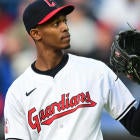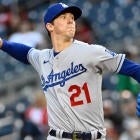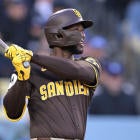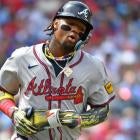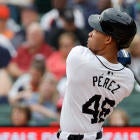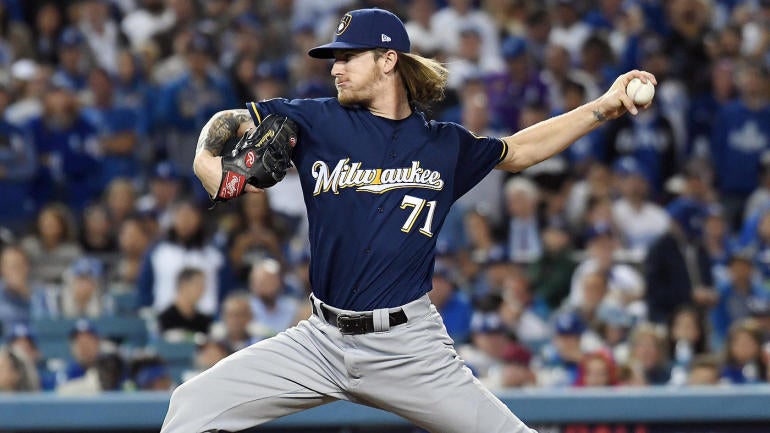
If you're just getting into your Fantasy Baseball draft prep, be warned: Relief pitcher prices are kind of wild right now. You might see multiple relievers drafted in the first three rounds in many leagues, with potentially as many as 10 inside of the top 100 picks. What's going on here?
Well, it's a reaction to how MLB teams are using their closers these days. Only nine different pitchers had 30 saves in 2021, and only another three even got to 25. There just aren't many closers you can look at on Opening Day and feel comfortable they'll get you a bunch of saves. Teams just don't really operate like that anymore, and when we're talking about drafts taking place during spring training, the number of closers we can even name confidently numbers in the low double digits – fewer than 20, for sure.
So, the guys who we know are closers are going to cost a lot more than they have in the past. And that's especially true over at NFC, where we're getting the data for this ADP review series from, since many of the leagues played on that site are draft-and-hold formats where you won't have the opportunity to make adds and drops.
Closers should and will go for less of a premium at the high end in other formats, but if you want one of the good ones, you'll still need to pay up. Here's how closers are being drafted since the start of March.

Fantasy Baseball Draft Kit
Your ultimate baseball draft guide
Dominate your Fantasy Baseball draft with our free Draft Kit, which gives you must-have positional and Top 300 rankings in a printable format. Plus track your draft with our lineup builder and salary cap tracker.
Thanks for signing up!
Keep an eye on your inbox.
Sorry!
There was an error processing your subscription.
ADP Reviews: C | 1B | 2B | 3B | SS | OF | SP | RP
Tier 1
- Josh Hader - 35.22
- Liam Hendriks - 35.36
Hader and Hendriks represent the top options, but they're also far and away the most expensive players at the position. As they should be. They have the elite ratios and strikeout volume. If you had to find a flaw in either, it's not out of the question Hader could get traded if the Brewers find themselves falling out of contention, as he's a free agent at the end of next season; Hendriks has as many as two years left on his contract after this season, but the presence of Craig Kimbrel will stick in the back of your head. That being said, it's hard to envision either of these guys losing their job minus some kind of disaster, and they're a lot less likely than anyone else to have said disaster strike.
Tier 2
- Raisel Iglesias - 54.7
You might be used to seeing Iglesias drafted a bit lower than this, but he's had two of his best seasons in a row and should once again close out a ton of games for the Angels – he led the majors in games finished in 2021. That didn't lead to a ton of saves, but if the Angels are good – famous last words? – he could top 40.
Tier 3
- Emmanuel Clase - 68.8
- Edwin Diaz - 73.19
- Ryan Pressly - 73.59
Clase doesn't get the strikeout numbers you typically want from an elite closer, because so much of his profile is built around generating weak contact. There's plenty of swing and miss in his game, of course, so it's not out of the question that he could take a step forward in that regard and join the ranks of the elite. If not, he'll keep generating elite ratios and broken bats and should be one of the best closers in the game outside of that elite tier.
People just don't trust Diaz, and it's not hard to blame them. He's been all over the place in his career; one season with a sub-2.00 ERA followed by one with a 5.59 mark; then he goes from a 1.75 to a 3.45. The underlying numbers are typically much more consistent, with a ton of strikeouts and very good ERA estimators, but he's been a high-variance pitcher in his career thanks to some homer and control issues. He's fine at this price, and might even be undervalued given the general air of untrustworthiness about him.
Pressly finally got a chance to close over the past two seasons and he's remained an excellent high-leverage reliever. He ranked eighth among relievers with a 27.2% K-BB%, and only takes a hit to his perceived value because his save total was pretty lackluster in 2021 – he only had 26 saves, however the Astros only had 34 as a team, so it's not like there's any risk in his role. He might be the best value at the position.
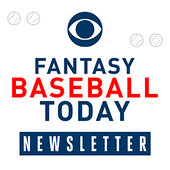
Fantasy Baseball Today Newsletter
Your Cheat Code To Fantasy Baseball
You're destined to gain an edge over your friends with advice from the award-winning FBT crew.
Thanks for signing up!
Keep an eye on your inbox.
Sorry!
There was an error processing your subscription.
Tier 4
- Aroldis Chapman - 92.67
- Kenley Jansen - 97.88
- Jordan Romano - 99.57
This tier is a little scary. Chapman continues to get strikeouts at an elite pace (97 in just 56.1 innings in 2021), but his control was a real problem last season, especially after the sticky-substance ban. He walked 17% of opposing hitters from June 1 on with a 4.95 ERA. He's also dealt with some nagging injuries over the past few seasons, and the Yankees have shown a willingness to pull him out of the closer role for stretches if they think it gives them the best chance to win. At this price, Chapman is fine, but the bottom could fall out here.
Or, Chapman could follow the Jansen path. The Fantasy community has spent the past three or four years waiting for the other shoe to drop with Jansen, but he had a bounceback season in 2021, adding about 1.5 mph to his cutter velocity and putting up his best numbers since 2017. Interestingly, he actually had a lower strikeout rate and higher walk rate in 2021 than he did the prior year, but made up for it by posting his best quality-of-contact data since 2016. Jansen's market was surprisingly slow this offseason, but the World Series champions in Atlanta opted to add Jansen despite the presence of a pretty good closer in Will Smith. Take that for a vote of confidence.
Romano struggled early last season and actually ended up losing his job before he even got a save. He didn't get his first one until May 11, but he was pretty spectacular from point on, posting a 1.99 ERA with 77 strikeouts in 54.1 innings. If he can avoid another slow start, we could be talking about Roman as one of those elite closers this time next year.
Tier 5
- Giovanny Gallegos - 129.04
Gallegos sits in this little tier by himself, a sign of the Fantasy community's confidence in him despite questions about whether he's actually the Cardinals closer. They haven't settled on one and may not, and they seem to like having Gallegos available to put out fires whenever he's needed. However, he was the closer down the stretch last season and had 11 saves in the month of September, and he could totally do the job if he gets the opportunity. If not? Well, you've spent a pretty high pick on a non-closer, but one who will give you elite ratios, tons of strikeouts, and enough saves that you probably won't regret the pick either way if you want to chase saves. I won't be doing it, but I get the appeal.
Tier 6
- Mark Melancon - 148.45
- Corey Knebel - 149.1
- Blake Treinen 150.8
- Michael Kopech - 165.74
- Luis Severino - 172.12
We're not quite in no-man's land, but we're not far off. The prices for Knebel and Treinen have been creeping up lately, to the point where it's probably more likely they're drafted in the Gallegos range than not over the past few days. Both are fine picks there, albeit with plenty of risk; both had their best seasons in a while in 2021, carry some injury risk, and have some role risk, too. However, Treinen is the most-likely saves source on the best team in baseball, while Knebel's got a pretty good Phillies squad on his side. Knebel's 25.2 innings in 2021 were his most since 2018, but he's preferable to Treinen at this point if only because it seems like the Dodgers really are leaning toward a committee to open the season.
Absolutely nobody is excited to draft Melancon coming off a 39-save season where he had a 2.23 ERA. Obviously, the move to Arizona plays a part in that, as they had the fewest saves in baseball as a team in 2021. They figure to be pretty bad yet again, but probably not anywhere close to 52-wins bad. Melancon isn't an elite closer, as he relies more on inducing soft contact rather than avoiding it, and watching him pitch can be a stomach-churning experience. However, he seems like a pretty safe bet for a decent save total before the trade deadline, if not all season.
Kopech and Severino are our first two startings pitchers with reliever eligibility, heretofore referred to as "SPaRPs". Between shoulder and elbow injuries, Severino has thrown just 18 innings since 2018, so there's obvious risk. However, he's also drawn positive reviews in spring training for the most part, so I don't mind taking the risk on him here. It's not clear how likely he is to provide much more than 150-plus innings, but if he's pitching more or less like himself – 3.18 ERA, 10.5 K/9 between 2017 and 2018 – there's a ton of value in that. Especially in points leagues, where that SPaRP eligibility matters more.
Kopech is a tougher nut to crack, because he might be more useful in Rotisserie leagues than points leagues, but that SPaRP eligibility matters less in that format. Kopech worked primarily as a reliever in 2021 and looked every bit like the elite pitching prospect he once was. His stuff was absolutely electric, and he put up a 3.50 ERA and 36.1% strikeout rate despite rarely having to use more than his fastball or slider. Kopech is a bit delayed in spring action after having COVID in February, and it's not clear if he'll be in the rotation for Opening Day, so that's one mark against him. The other is the fact that we just don't know what kind of role he is likely to have; he's thrown just the 69.1 innings from last season since 2018, so will the White Sox even let him get to 150 innings? Will they let him pitch deep into games when he's in the rotation? Will they skip starts or pull him from the rotation for stretches to manage his innings? Those are all important questions to ask, but when we're talking about this range of the draft, I'm willing to take a chance on Kopech's upside even with those questions.
Tier 7
- Scott Barlow - 179.48
- Camilo Doval - 182.2
- Craig Kimbrel - 184.05
- Ranger Suarez - 187.98
- Taylor Rogers - 193.99
- David Bednar - 212.07
- Tanner Houck - 212.73
Houck and Suarez are your SPaRPs in this range, though Suarez seems much more likely to be used as a traditional starter, but at the beginning of the season and all season long. Houck remains an intriguing talent, but I'm not sure he'll ever be much more than just a decent Fantasy option, given how shallow his repertoire is. His slider is an incredible pitch, but that might be the only above-average offering he brings to the table, and I'm not sure it's enough to get through a lineup three times consistently. Suarez is similarly dependent on an excellent changeup, but he did at least show down the stretch he can both hold up and excel as a starter. I'm skeptical about whether he'll be able to do it for a full season, but I don't mind his cost.
Kimbrel is the highest-upside option among this group, but he's also currently the one with the biggest roadblock to value. He needs to be traded before opening day, and we just really haven't heard much in that regard this spring. If he's setting up for Hendriks, he can still have value if he pitches well, but the only way you'll be happy you drafted him is with a trade (or injury, I suppose, but we don't root for those).
The rest of this group is made up of the relievers we're pretty sure are good and hope are their team's likeliest first choice for the ninth. But we really don't know aside from maybe Barlow. We're talking upside picks here, and ending up with one or two of them as a flier is probably a good idea. My favorite is probably Rogers or Bednar, given the limited competition. Doval figures to see his ADP slide given Gabe Kapler's announcement that Jake McGee will be leading the committee for the Giants, though he is still worth drafting, especially in 15-teamers. McGee figures to go in the 150 range now.
Tier 8
- Gregory Soto - 216.56
- Joe Barlow - 244.98
- Garrett Whitlock - 253.86
- Dylan Floro - 254.58
- Lou Trivino - 256.22
- Matt Barnes - 261.15
And here's where you're just hoping for saves, with the exception of Whitlock, who could potentially make an impact as a starter. Hopefully, the final few days before the start of the season will provide the clarity we need to know who to target among these options, but there isn't much to be excited about right now.















